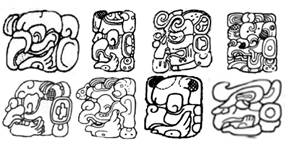![]()
![]()
![]()
K&H.p55.#1.2 TOK.p36.r1.c1 25EMC.pdfp45.#5.2
PIK / PIKHAAB? PIK PIK / PIH


K&L.p62.#1 IC.p16.pdfp20.#5.1
PIK BAK’TUUN / PIK

![]()
MHD.ZC3a.1&2&3&4&5 0200st
PIK PIK
![]()
![]()

K&H.p55.#1.1 = BMM9.p13.r4.c4 TOK.p27.r2.c3 25EMC.pdfp45.#5.1&3&4
PIK / PIKHAAB? PIK PIK PIK / PIH




K&L.p62.#2 iC.p16.pdfp20.#5.3&4 Montgomery = Coll-1
YAX HS2 Step 7 M1
PIK BAK’TUUN / PIK 9.PIK


MHD.SB1a.1&2&3&4&5&6 1033st
PIK -




Houston-HaHaDP.p109.fig4.11 Stuart Stuart-TIfTXIX.p61.fig34 Schele
DPL HS4 Step 1 B1 LAC Panel 1 A3 PAL Temple 19 Platform Passage S-1 B1 PAL PT P5
9.PIK 9.PIK 12.PIK PIK.<ki:yi>


![]()
MHD.ZHA.1&2&3 0285bv 0285bb
PIK - -


25EMC.pdfp9.r5.c2 IC.p16.pdfp20.#5.2
PIH BAK’TUUN / PIK
![]()
![]()
![]()
K&L.p62.#2.9 = IC.p16.pdfp20.#5.6 IC.p16.pdfp20.#5.5 = 1033fh
YAX Lintel 48 B3-B4 PAL PT B3-B4
PIK BAK’TUUN / PIK
· BMM9 does not give a boulder variant of PIK.
· Variants (5):
o A. Abstract (“2-KAWAK”):
§ Two KAWAKs next to one another.
§ (Optionally) a hi (reduced (“knot”) variant) – when present it should be read as PIH rather than PIK?
o B. Bird-head:
§ AT-E1168-lecture6.t0:34:55-36:55 discusses the head variants of PIK, WINIKHAAB, and HAAB. For PIK, Tokovinine explains that:
· It’s a raptorial bird with a “darkness” element (making it a nocturnal bird).
· [Sim: note that this is the bird-head which does not have HIX infixed in the eye, unlike WINIKHAAB and HAAB, instead there’s a “left feeler” in the eye.]
· It has a human hand instead of the lower part of the beak.
§ Summary of distinguishing characteristics: a bird-head (usually with two o feathers, one on each side of the head) with hand-jaw, and with (optionally) the “darkness” property marker in the forehead.
o C. CHAN-like:
§ Top: CHAN = sky.
§ Bottom: wa / wu.
That this is a separate glyph is supported by MHD, which does not consider it to be CHAN + wu/wa, but instead an independent variant of PIK: MHD.ZHA. It gives 7 hits for a search “blcodes contains ZHA”. Bonn does the same, with 0285bv. In addition, Bonn recognizes a “reduced form” of this variant, with just the “legs” at the bottom. This is probably part of the well-known phenomenon of the bottom of a full variant of a glyph “sticking out” at the bottom from “behind” another main sign which has been put in front of it (relative to the reader), in the same way as reduced forms of NAL or AJAW “stick out” at the top.
o D. HAAB-based:
§ Top: Two KAWAKs next to one another.
§ Bottom: HAAB.
o E. Full figure:
§ So far, I’ve only seen them in PAL PT and YAX Lintel 48.
· MHD statistics (2024-09-29). These statistics are available only for the abstract/2-KAWAK, bird-head, and CHAN-like variants, as I’m not aware of MHD codes for the other two – if they even exist. And even if they did and I knew them, the number of hits for these two obscure variants would probably be extremely low anyway. The MHD search was “blcodes contains <3-character-MHD-code>”:
o Abstract/2-KAWAK/MHD.ZC3a: 304 hits.
o Bird-head/MHD.SB1a: 419 hits.
o CHAN-like/MHD.ZHA: 7 hits.
The very few occurrences of the CHAN-like variant is not at all surprising, but the considerably greater number of occurances of the bird-head variant compared to the abstract/2-KAWAK variant is surprising. I had expected the abstract variant to be much more common than the bird-head variant (as is the case for WINIKHAAB and HAAB).
· Do not confuse the head variant of MIH with the visually (slightly) similar (bird-)head variant of PIK/PIH. They are both head glyphs with a hand-jaw, but:
o MIH is an anthropomorphic head while PIK/PIH is a bird-head.
o MIH can have an optional %-sign (or three non-touching dots in a triangular formation, triangle pointing downwards) and (also optionally) some skull/bone/death-like characteristics, absent from PIK/PIH.
These two will generally only occur in different contexts (e.g. the former as a coefficient and the latter as a calendar unit), so there should be no confusion. But “abstractly”, when thinking about “loose glyphs” out of context, it’s easy to confuse the two.